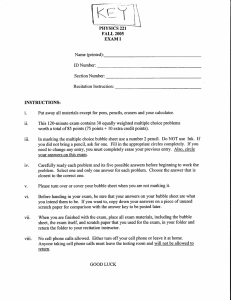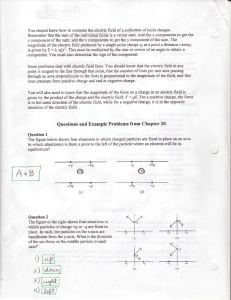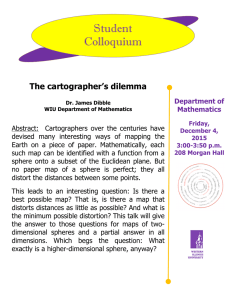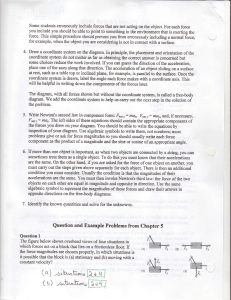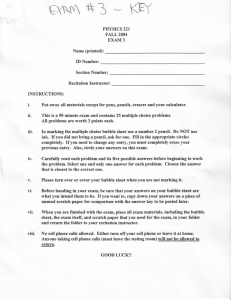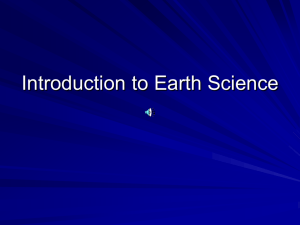PHYSICS 221 FALL 2OO5 FINAL EXAM
advertisement
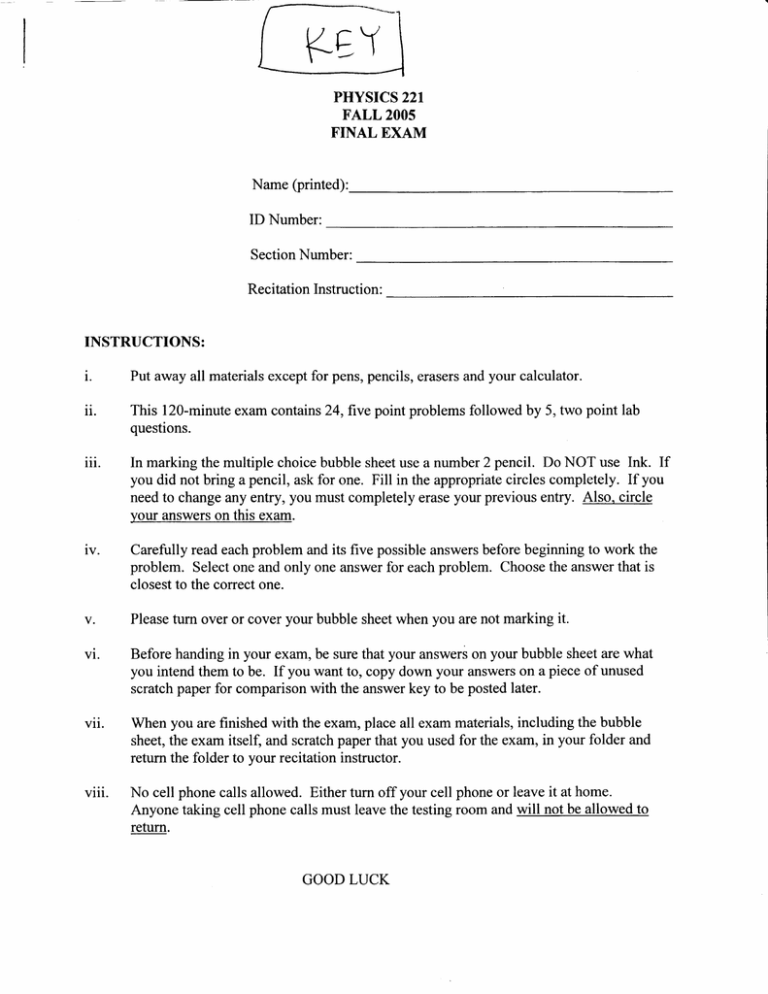
PHYSICS221
FALL 2OO5
FINAL EXAM
Name (printed):
ID Number:
SectionNumber:
RecitationInstruction:
INSTRUCTIONS:
i.
Put away all materialsexceptfor pens,pencils,erasersand your calculator.
ii.
This 120-minuteexam contains24,fle point problemsfollowed by 5, two point lab
questions.
iii.
In marking the multiple choicebubblesheetuse a number2 pencil. Do NOT use Ink. If
you did not bring a pencil, ask for one. Fill in the appropriatecircles completely. If you
needto changeany entry, you must completelyeraseyour previous entry. Also. circle
vour answerson this exam.
iv.
Carefully read eachproblem and its five possibleanswersbefore beginning to work the
problem. Selectone and only one answerfor eachproblem. Choosethe answerthat is
closestto the correct one.
v.
Pleaseturn over or cover your bubble sheetwhen you are not marking it.
vi.
Before handing in your exam, be surethat your answerson your bubble sheetare what
you intend them to be. If you want to, copy down your answerson a piece of unused
scratchpaper for comparisonwith the answerkey to be postedlater.
vii.
When you are finished with the exam, place all exam materials,including the bubble
sheet,the exam itself, and scratchpaperthat you usedfor the exam, in your folder and
return the folder to your recitation instructor.
viii.
No cell phone calls allowed. Either turn off your cell phone or leave it at home.
Anyone taking cell phone calls must leavethe testing room and will not be allowed to
return.
GOODLUCK
61. A metallic sphereof radius a is at the centerof a
metallic shell of radii b and c. The net chargeof the
sphereis q (q > 0). The net chargeof the shell is -q.
Comparethe electric potential at points X, Y andZ.
A. V x > Vv> Vz
B . V x > Vv: Vz
V x : Vv> Vz
Vx: Vv<Vz
E. V x < V v < V z
6
62. Four chargesare fixed forming a squareof side a as shown in the figure below. A fifth
chargeq - 3.0 nC is placed at the centerof the squareand released.Find its kinetic energy as
it goesthrough point P (halfivay betweenthe two negativecharges).
*aQ
Q-o
XP
*oo
6
O-s
2.3 x l0-6 J
4.0 x l0-6 J
C . 6.7 x 10-6J
D . 8.2 x l0-6 J
E. Chargeq will never get to point P.
Q:2.0nC
a : 3 . 0c m
The next three questionsrefer to the following circuit with three capacitorsand a battery:
Cr : 10.0pF
Cz: 20.0pF
Ct:40.0pF
V o : 3 0 . 0V
G.
Determinethe equivalentcapacitance
of thecircuit.
A. 5.71pF
B. 8.57pF
14.2uF
,/\.C.
aJ T.3 1tF
E. 70.0pF
64. Whatis the energystoredin Cz?
A. 0.20mJ
B. 0.90mJ
C. 2.0mJ
eo)4.omJ
Y6.omJ
65. With the capacitorsstill connectedto the battery,a dielectric is insertedbetweenthe plates of
before and the
Cr. After this, the chargeon the platesof Cr is
before.
chargeon the platesof Cz is
A.
tPJ
C.
D.
E.
-4A.
larger than, larger than
larger than, the sameas
the sameas, larger than
smaller than, the sameas
larger than, smaller than
v
66. Three identical bulbs with temperatureindependentresistancesR : 744 C)are connectedto
an ideal battery as shown. The switch is initially open.
When the switch is closed.bulb #1 is
A.
(BJ
C.
D.
E.
/-^,
before and
bulb#2.
as bright as, as bright as
as bright as, brighter than
dimmer than, as bright as
dimmer than, brighter than
dimmer than. dimmer
v
67. Find the current through bulb 3 in the circuit from last problem when the switch is closed.
^.
A
ur 0.6e
B.
c.
D.
E.
1 . 0A
1 . 4A
2 . 1A
2 . 8A
68. Considertwo parallel infinite and very thin plates separatedby a distanced: 8.85 cm. The
left platehas chargedensityor- *3.00 nC/mt. The right plate haschargedensityon: -6.00
nClmz.The potential is chosento be zeroat the positive (left) plate. What is the potential at
point P, located 8.85 cm to the right of the right plate?
A. -60 V
(D -3ov
_,+
6y
Op
C. OV
D. 3OV
E. 6OV
xp
€
d
69. Which of the following statementsabout equipotentialsurfacesis false?
A. The electric field is always perpendicularto the equipotentialsurface.
B. The work done by the electric field on a chargemoving betweentwo points on an '
equipotentialis zero.
q. The surfaceof an empty cavity inside a conductorin equilibrium is an equipotential.
@ The surfaceof uny.huiged body is an equipotential.
E. Any surfaceinside a conductorin equilibrium is an equipotentialsurface.
70. Three ideal batteriesand two resistorsare connectedin the circuit shown below. Find the
current through battery #2.
Rr
R3
tl:l0V
tz: 20V
t 3 : 3 0V
Rr:l0O
Rz:20 O
R::30O
R+:40O
(D 0 . 1 9A
B.
C.
D.
E.
0.26A
0 . 3 8A
0.46A
0 . 5 0A
71. A copperspike is weldedto a coppersphere.The objectis then given a positive chargeQ.
Comparethe electric potential and the magnitudeof the electric field at points X and Y,
which are right abovethe surface(ust outsideof the metal) of the object in two different
locations (seefigure).
f,x
x l
A.
B.
C.
D.
@
Ex: Ev
Ex: Ey
Ex< Ev
Ex> Ev
V x : Vv
V x < Vv
V y < Vv
V x : Vv
Ex<Ev V x : Vv
72. A resistor,a capacitor,an ideal battery and a switch are usedto constructthe circuit shown
below.
t
LJ
\
s : 2 0 . 0V
R: 15.0
O
C : 0 . 3 0F
tl
The switchis initially openandthe capacitoris uncharged.
At t :0, the switchis closed.
How long will it takethe capacitortoget 90%of its final charge?
A.
B.
C.
D.
0.47s
1 . 9 5s
4 . 5 0s
9.89s
s
lU 10.4
73. Three blocks of massesMt, Mz andMj areconnectedas shown below with ideal, massless
strings and an ideal, massless,frictionlesspulley. The force of friction betweenthe blocks
and the horizontal surfaceis negligible. The systemis released.Determine Tlfor Mr : I kg,
M2:Ikg,Ms:2k5.
A.3.3N
G)4.eN
c. 9.8N
D . 1 4 . 7N
E . 1 9 . 6N
74. A 3-kg block slides on a horizontal floor towards a spring with constantk : 2000 N/m
attachedto a wall (seefigure below). The spring is parallel to the trajectory of the block, and
perfectly aligned with it. The coefficient of kinetic friction betweenthe block and the floor is
0.5. The block hits the spring and compressesit2.5 cm before stopping.What was the speed
of the block when it first cameinto contactwith the spring?
m:3 kg
A.
B.
C.
D.
k:2000 Nim
0.26m/s
0.49m/s
0.65m/s
0.74mls
@ o.8tm/s
75. A boy pushesa wooden box along a rough horizontal floor at constantspeedby meansof a
force F asshown. Inthediagram/isthemagnitudeoftheforceoffriction.Nisthe
magnitude of the normal force, and ^F',is the magnitude of the force of gravity. Which of the
following must be true?
Fe: Force of Gravity
f : Frictional Force
N : Normal Force
A. p:fandN:F,
B. p:fandN>F"
C. P>fandN.F,
D.P>.fandN:Fr
@ Noneof these
I
*F
t
o {= t-c'o P
76. Amass,M, moveson a frictionlesstrack,thatincludesan inclinedplaneanda loop-the-loop.
If theradiusof the loop is R andthe inclinestarts2.25R abovethebaseof thetrack,what is
the normalforceexertedby thetrackon the massat the top of the loop?
A.0
B. 0.25Mg
C. 0.50Mg
D . 1 . 0 0M g
@ Themassdoesnot makeit to thetop of the loop.
77. A massis attachedto a rope that is 2.00 m long.
The rope is attachedto the ceiling. The mass
and rope form a conical pendulum with the mass
moving in a horizontal, circular path. If the rope
makesan angle of 25.0owith respectto the vertical
(as shown), what is the period of the pendulum?
A. 0.86s
B . 1 . 2 0s
C . 1 . 8 4s
.2-
(!t 2.70s
E. Answer dependson the value of the mass.
rq
/
/ /
\
+
l
-.b_
_
'
|
I
I
I
I
78. A 10 kg bag is pulled along a rough horizontal floor by three constantforces of 15 N each
(seefigure below). The bag is initially at rest and moves at 4.0 m/s after being draggedfor
l0 m. What is the coefficient of kinetic friction betweenthe bag and the floor?
F r : I 5N
Fz:15N
Fg:15N
A) 0.18
B) 0.2s
@t+
D) 0.41
E) 0.s0
79.Tluee blocks (Mr: I kg, Mz: 2kg, Ml :3 kg) are zurangedadjacentto eachother,
horizontally in a row on a frictionlesssurface. A 10 N force is applied from the left on the
left-most block. The blocks can be placed in any order, left to right. What is the largest
possibleforce betweenthe left and middle block?
A . 3 . 3 3N
B. 5.00N
t 6.67N
aJ 8.33N
E . 1 0 . 0N
80. A 100-gball traveling at20 m/s horizontally to the left is hit by a racket. The ball and the
racket are in contactfor 0.20 ms. As a result of the blow, the ball leavesthe racket traveling
upwardsat an angle of 90 degreeswith the horizontal, at 20 m/s. What is the magnitudeof
the averageforce exertedby the racket on the ball?
A . 1 . 0x 1 0 4N
CD r.4x lo4N
C. 2.0x toa N
D. 2.5 x l}a N
E. None of the above
81.A 20-kgchild standson a 10-kgwagonthatrolls at2.0m/sto theright. After thechild
jumps to the left, at 1.0m/s relativeto the ground.Whatis the wagon'sfinal speed?
A. 2.0mls
B. 4.0m/s
^C. 6.0m/s
(O
8.0m/s
E. 10m/s
82. A uniform rod of length I .00 m and mass3.00 kg is attachedto the ceiling by a hinge. A
small clay ball of mass mftaveling horizontally with a speedof 4.00 m/s hits it right at its
center(seefigure below) and sticks to it. If the speedof the ball, just after the collision, is
2 m/s. what is the ball's mass?
A.8ke
hinge
@ 4k;
C. 2ks
D. lkg
E. Any masswill give
this result.
83. A 1.20m long, 50-kg beamhingedto the wall is kept in equilibriumthrougha cableattached
to the free end and anchoredto the wall 0.40 m abovethe hinge, seefigure below.
Determinethe tension on the cable.
A. 245N
.b,490 N
qcJ
775N
D. 992N
E. 1200N
[.?-o'"
84. A very larg9, insulating slab with a thicknessof 10.0 cm has a uniform chargedensity of
+3.00 x 10-8Clm3. What is the magnitudeof the electric field 4.00 cm from the middle plane
of the slab?
A. 7.32x 1 0 6I
C
B . 1 . 6 8x 1 0 5I
C
C . 1 . 3 5x 104I
C
( ' D . l 1 . 3 6x 1 0 2I
C
E. 6.78x 1 0 tI
c
PHYSICS221- Fall, 2005
LaboratoryFinal
As you did in lab, consider the motion of a cart which is given an
"motion detector".
initial velocity up an inclined track toward a
Assume the cart goes part of the way up, and then returns back down
the track. (As was done in lab, assumethe sensorgives positions
relative to the X axis illustrated above).
I
fl
o
-*
tr
85.
Which of the following best illustratesthe acceleration,oy, of the cart versustime (during the
sameperiod)?
86.
Assumethat you havea load cell (suchas usedin22l
lab) that producesthe outputs shown in the table for the
conditionsdescribed.Also assumethat the cell is
designedto have a linear relation betweenits output and
the force appliedto the sensitiveportion of the cell.
Basedupon this information, estimatethe calibration
constantof this cell (in units of pV/lb).
A) 3s.2
B) tso
f.):o.o
\-/
D) 0.033
E) Cannot be determinedfrom the informationgiven.
Cell condition
Cell output
cell lying on table
9pv
cell alonehanging
26 1tY
5.0 lb sackhanging
from cell
176 StY
87.
As in the Collision in Two Dimensionslab, consider
two air pucks sliding with little friction on a smooth,
level surface. Assume they each are moving with
some velocity, collide, and then one subsequently
reboundsfrom the edge of the table.
Consider the total vector momentuffi, P, of the two
pucks (only). Let Pt be its value before the collision of
the pucks, P, its value after collision, and P, its value
after one of the pucks hits the edgeof the table.
Which of the following most accuratelydescribesthe
relationship betweenthesequantities?
P r : P 2 : &
P r : P 2 * P ,
c)
P r + P 2 _ &
P r * P 2 * &
Without knowingwhetherthe collisionsareelastic,onecannotsay.
D)
E)
88.
Using the rotating wheel apparatussuch asyou usedin lab, a disk (which is not spinning)is
droppedconcentricallyupon the wheel as it is rotatingfreely. Assumethat the disk has a moment
of inertia of 0.5 Is , where Io is the momentof inertia of the rotatingwheel. Which of the following
graphsbestrepresentsthe angularvelocity, (D,as a function of time before,during, and after the
diskis dropped?
A
89.
c
B
Considera hollow metal spheremountedon a thin insulatingrod. Using standard
the largestpossibleelectricchargeis placedon
apparatus(e.g.,an electrophorus),
the sphere.
Where is the electric field largest,and for a sphere of a given size, what factor
determinesthe magnitudeof the maximum charge?
A
B
C
D
E
location where electric
field is larsest
of sphere
outside
iust
iust outsideof sphere
center of sphere
center of sphere
none ofthe above
factor that determinesthe
magnitudeof the maximum charge
dielectric strengthof air
Wpe of metal
dielectric strengthof air
type of metal
End of Laboratory Exam Questions
E
